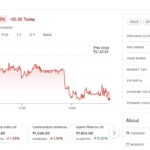Filtering high liquidity stocks is an important consideration when trading in intraday trading. Here are some ways to filter high liquidity stocks:
- Look for high trading volumes: One of the best ways to identify high liquidity stocks is to look for those with high trading volumes. These are stocks that are traded frequently and in large quantities, which means that there is a large pool of buyers and sellers in the market. You can use trading platforms or websites that offer real-time data on trading volumes to find these stocks.
- Check bid-ask spreads: Bid-ask spreads refer to the difference between the highest price that buyers are willing to pay and the lowest price that sellers are willing to accept for a particular stock. A high liquidity stock will typically have a narrow bid-ask spread, indicating that there are plenty of buyers and sellers in the market. You can check bid-ask spreads using trading platforms or websites that offer real-time data on stock prices.
- Look for stocks with high market capitalization: Market capitalization refers to the total value of a company’s outstanding shares of stock. Companies with high market capitalization tend to have high liquidity stocks, as they are more widely held and traded. You can use financial websites that provide information on market capitalization to find these stocks.
- Check the stock’s average daily range: A stock’s average daily range is the difference between its high and low prices over a given period, typically 20 to 30 days. A high liquidity stock will typically have a larger average daily range, as there is more trading activity and volatility. You can use trading platforms or websites that offer real-time data on stock prices to find stocks with a high average daily range.
Remember that high liquidity does not necessarily mean that a stock is a good investment. Always do your own research and analysis before making any trading decisions, and consult with a financial professional if necessary.
High-liquidity stocks are a key part of the future of the stock market. They offer investors the ability to buy and sell shares quickly, which is important for getting a quick snapshot of the market. In addition, high liquidity stocks tend to have low prices-to-book ratios, which means they’re liquid and can be sold quickly. This makes them great candidates for investment vehicles such as hedge funds and mutual funds.
What is high liquidity?
A high liquidity stock is a company that has a large number of shares that are easily sold and bought, which makes it a very good choice for investors looking for fast-paced, market-driven investment. These stocks are often traded on exchanges with high levels of liquidity, making it easy to buy and sell them.
What are the benefits of investing in high-liquidity stocks?
The benefits of investing in high-liquidity stocks can be many, but some of the most common reasons people invest in them include:
1) They offer quick and easy access to the stock market;
2) They provide stability and predictability in the stock market;
3) They offer an opportunity to make quick and large profits;
4)They give you the option to hold onto the stock for a longer period of time; and
5) They can provide you with the potential to make a lot of money from stock market investments.

What is the main difference between high-liquidity stocks and other stocks?
High-liquidity stocks are stocks that have high levels of liquidity, or the ability to buy and sell shares quickly. This means that they can attract buyers who want to trade shares quickly and easily.
Subsection 2.2 What are the different types of investors who might want to invest in high-liquidity stocks?
Some potential investors in high-liquidity stocks might be traders, investors with experience in advanced trading skills, or people who are looking for an opportunity to make money fast.
What are the different measures of high liquidity?
Some measures of high liquidity include a company’s ability to issue new shares on a swift and regular basis, its stock price being within a certain range, and the availability of debt financing.
What are some measures of the future success of high-liquidity stocks?
Some potential indicators of future success for high liquidity stocks include whether the company is growing fast enough, whether it has affordable debt financing available, and whether investors are willing to pay a higher price for the stock.
Conclusion
Investing in high-liquidity stocks can provide you with a great return on investment and the ability to quickly move money around. In addition, these stocks are often easier to trade than other stocks, which makes them an ideal choice for day traders and investors who want to make large profits quickly.





![Mastering Advance Option Chain Tool [AOC]: A Trader’s Key to Success](https://seorub.com/wp-content/uploads/2023/07/A-trader-life-with-advance-option-chain-tool-AOC1-150x150.jpg)
